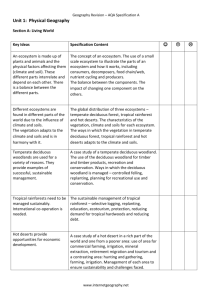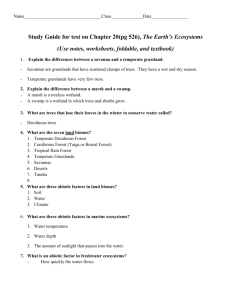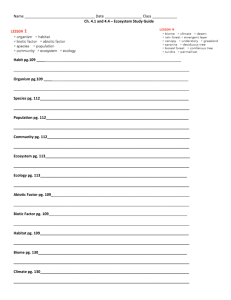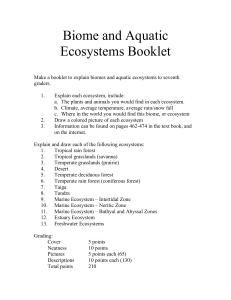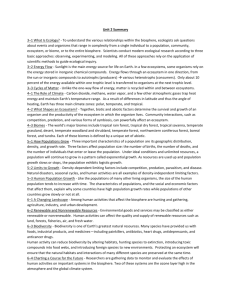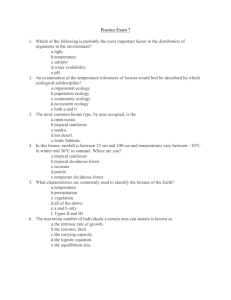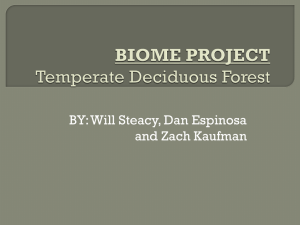Puzzling Ecosystems
advertisement
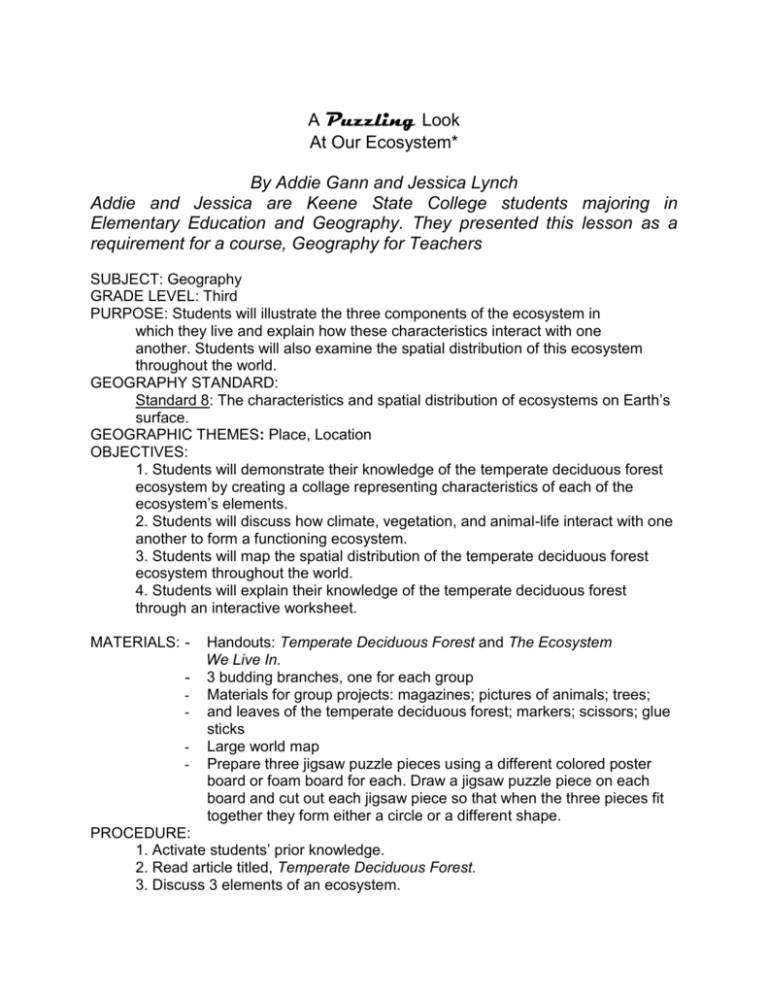
A Puzzling Look At Our Ecosystem* By Addie Gann and Jessica Lynch Addie and Jessica are Keene State College students majoring in Elementary Education and Geography. They presented this lesson as a requirement for a course, Geography for Teachers SUBJECT: Geography GRADE LEVEL: Third PURPOSE: Students will illustrate the three components of the ecosystem in which they live and explain how these characteristics interact with one another. Students will also examine the spatial distribution of this ecosystem throughout the world. GEOGRAPHY STANDARD: Standard 8: The characteristics and spatial distribution of ecosystems on Earth’s surface. GEOGRAPHIC THEMES: Place, Location OBJECTIVES: 1. Students will demonstrate their knowledge of the temperate deciduous forest ecosystem by creating a collage representing characteristics of each of the ecosystem’s elements. 2. Students will discuss how climate, vegetation, and animal-life interact with one another to form a functioning ecosystem. 3. Students will map the spatial distribution of the temperate deciduous forest ecosystem throughout the world. 4. Students will explain their knowledge of the temperate deciduous forest through an interactive worksheet. MATERIALS: - Handouts: Temperate Deciduous Forest and The Ecosystem We Live In. 3 budding branches, one for each group Materials for group projects: magazines; pictures of animals; trees; and leaves of the temperate deciduous forest; markers; scissors; glue sticks Large world map Prepare three jigsaw puzzle pieces using a different colored poster board or foam board for each. Draw a jigsaw puzzle piece on each board and cut out each jigsaw piece so that when the three pieces fit together they form either a circle or a different shape. PROCEDURE: 1. Activate students’ prior knowledge. 2. Read article titled, Temperate Deciduous Forest. 3. Discuss 3 elements of an ecosystem. 4. Create collage on jigsaw puzzle pieces. 5. Share jigsaw puzzle pieces. 6. Discuss meanings of temperate, deciduous, climate, and ecosystem. 7. Find world locations of temperate deciduous forests. 8. Review elements of ecosystem interactions. PRESENTATION: 1. Use a branch from a deciduous tree to begin a discussion about what the branch can tell us about the area in which we live. 2. Have students read the article titled, Temperate Deciduous Forest. 3. Discuss the article with students. Have them define the three elements read about in the article: climate, vegetation, and animals. Develop an understanding that each component of an ecosystem affects the other components (e.g. deciduous trees lose their leaves in the winter and animals are affected by the climate because they must adapt to the changing seasons). 4. Divide the class into three groups and give each a jigsaw puzzle piece. Each jigsaw piece will be used to represent one of the three elements of a temperate deciduous forest. Students will use magazine pictures to create a collage on the jigsaw pieces to depict the characteristics of their assigned ecosystem element (climate, vegetation, or animals). 5. Once all jigsaw collage pieces are completed, have students share their jigsaw puzzle pieces by fitting all three pieces together. 6. Students use the completed jigsaw puzzle to discuss the elements of an ecosystem (climate, vegetation and animals) and explain how each element can affect the other two. Have the class create their own definitions for temperate, deciduous, climate and ecosystem, based on the information they gathered in preparing their jigsaw puzzle. 7. Have students locate temperate deciduous forests on a world map. Then have students show the location of temperate deciduous forests, found in the middle latitudes around the globe, by using post-it notes to mark locations on the world map. (Each post-it note will have the name of a region or country that is part of the temperate deciduous forest ecosystem.) Ask students to look for patterns of how the temperate deciduous forest is distributed about the world. 8. Review by completing the worksheet, The Ecosystem We Live In. Use a blank world map on which to locate and color the areas where temperate deciduous forests are located. Adapted From: *Puzzling Ecosystems. Indiana’s Academic Standards and Resources, Indiana Department of Education. Retrieved May 9, 2006, from http://www.indianastandards.org/resources.asp?Subject=soc&Grade=3&Standar d=3&Indicator=3.3.5&Resource=13027 The rest of the lesson and accompanying materials can be found at our NHGA web site: www.nhga.net Temperate Deciduous Forest The ecosystem that we live in is called the temperate deciduous forest. Most of these forests are found in the Northern Hemisphere, although smaller areas are found in the Southern Hemisphere. It is a temperate ecosystem because the temperature changes throughout the year. Because of this, there are changing seasons. The average temperature is about 50 degrees Fahrenheit and the average amount of rainfall in a year is between 30 and 60 inches. In the winter this rainfall takes the form of snow or sleet. During the fall, the leaves on the deciduous trees change color and eventually fall off. They grow back again in the spring. This process helps trees survive the long, cold winters. There are many different trees and other types of vegetation in this ecosystem. Some of these include: oak, maple, beech and hickory, small shrubs and moss which can grow on the shady forest floor where there is very little sunlight to grow. This vegetation is also important to animals, which use it for shelter and food. A variety of animals live in this ecosystem. Some include deer, brown bears, and smaller animals like foxes, raccoons, squirrels and chipmunks. Animals in this region have adapted to the changing seasons and the cold winters. Many store their food in the fall and hibernate in the winter. Others, like many birds, migrate south during the winter season. Name: ___________ Date: ____________ The Ecosystem We Live In 1. What is an ecosystem? 2. What is the name of our ecosystem? 3. What is the climate like? 4. What is the vegetation like? 5. What are some of the animals found? 6. List 3 ways that the parts of an ecosystem affect one another: 1. 2. 3. World Political Outline Map ©2003-2005 EnchantedLearning.com
